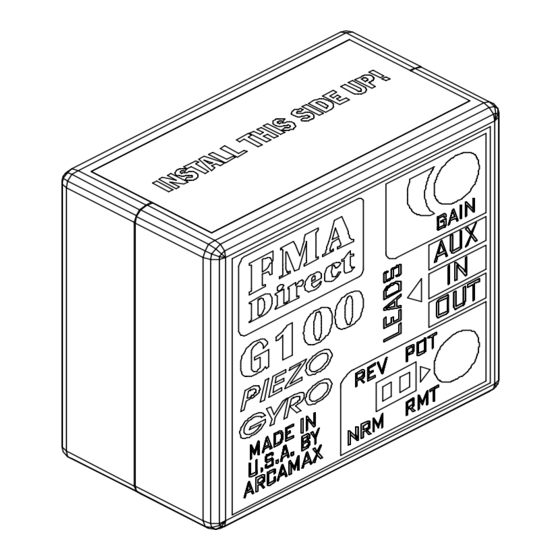
Advertisement
Quick Links
•
USING REMOTE GAIN: Remote gain is an extremely useful feature of the G100. When
using the remote gain input to the G100, the gyro's gain can be controlled from the transmitter
via an auxiliary channel on the receiver. Unlike most gyros on the market, the G100 remote
gain is fully proportional.
Setting Up For Remote Gain: To set the system up for remote gain, perform the following:
a)
Position the POT/RMT program dip switch to the RMT setting to defeat the gain
control trim pot and enable the AUX input on the gyro.
b)
Plug the AUX lead into a proportional auxiliary channel. A switch channel such as
landing gear can be used as long as the end-points are adjustable in the transmitter.
Note: the simplest way to use the G100 with remote gain is to utilize an auxiliary
channel that has variable gain. This way, gain can easily be controlled during flight by
moving the transmitter knob. If the transmitter being used does not have a variable
auxiliary channel, gyro operation can still be set up for remote gain operation using a
switched type auxiliary channel such as landing gear. This setup will provide for two
gain settings; the end-point adjustments in the transmitter can be used to set high and
low gain values.
c)
With the radio system ON, move the model about the control axis while moving the
gain channel knob or switch on the transmitter. You should notice the sensitivity of the
gyro change as the auxiliary channel control is moved.
With a computer, programmable transmitter, the versatility of the G100 can be realized
to an even greater extent. For instance, the gain channel can be mixed with the flight mode
switch so that two gain options are available, one setup for hover, and a different setup for
forward flight. This setup is ideal because the gain required for hover will usually be greater
than the gain required for forward flight as the forward motion of the helicopter tends to
restrict tail rotation.
FLYING:
•
PRECAUTIONS:
1.
It is extremely important that the model be at ambient temperature before the system
is powered up for flight. Never take the aircraft out of a warm car on a cold day and
power up the system right away. You must allow the model to sit for 10 to 15 minutes
on the ground. In order to perform properly, the gyro must be at the same temperature
as the air.
2.
After powering up the system, the aircraft must remain absolutely still for 5 seconds. If
these precaution are not taken, trim changes could occur throughout the flight.
•
FIRST FLIGHT: The gain should be set to 25% on the initial flight. Hover the helicopter for a
short moment, then increase the gain.
achieved. If the gain is turned up too high, the helicopter may start to oscillate back and forth
rapidly. This condition is termed "hunting".
Good luck and enjoy the high performance operation of your new G100!
IN CASE OF PROBLEMS:
1.
The G100 gyro is designed and manufactured by Arcamax, Inc.
2.
You may call Arcamax ((618) 453-4428) with technical questions or for issues of
repair.
Repeat this procedure until a smooth hover is
INTRODUCTION:
CONGRATULATIONS!!! Your decision to purchase the FMA Direct G100 piezo gyro assures
you of the highest standards of design available to the R/C industry at an affordable price. The
G100, designed by Arcamax, Inc., and distributed exclusively by FMA Direct, is designed for use in
high performance helicopters and aircraft. Due to its solid state piezo sensor, unique temperature
compensation circuitry, and precision switching voltage regulator, it offers performance unsurpassed
by gyros from other manufacturers. The G100 operates as a standard "rate" gyro, or, if used in
conjunction with a programmable transmitter, proper mixing setups will allow the G100 to be
configured as a "stick priority" gyro.
Although intended primarily for helicopter use, the small size, low weight, low current
consumption and high sensitivity make the G100 ideal for scale aircraft, ducted fan models, and
experimental aircraft such as VTOL.
Piezo gyros are a significant technological advance over the old motor gyros. The absence of
moving parts greatly decreases current consumption, extending both run time and the life of the
gyro. Furthermore, their low mass increases responsiveness. It is important to understand that a
piezo crystal is fragile. Special precautions should be taken when installing and using your
new gyro. Please read the manual completely before attempting to install and fly your new G100.
SPECIFICATIONS:
SIZE:
1.53" X 1.45" X .81"
WEIGHT:
1.0 OZ.
OPERATING VOLTAGE:
+4.0V TO +6.5V
CURRENT DRAW:
20 mA (max)
OPERATING TEMP:
23°F - 155°F (-5°C - 70°C)
SERVO PULSE WIDTH:
.75 - 2.25 mS
SENSITIVITY:
1/10° per second
FMA, Inc.
5716A Industry Lane
Frederick, MD 21704
Sales: (800) 343-2934 -Technical: (301) 831-8980
OWNER'S MANUAL
NOTE: PLEASE READ MANUAL
COMPLETELY BEFORE OPERATION
Advertisement

Summary of Contents for FMA Direct G100
- Page 1 USING REMOTE GAIN: Remote gain is an extremely useful feature of the G100. When using the remote gain input to the G100, the gyro's gain can be controlled from the transmitter via an auxiliary channel on the receiver. Unlike most gyros on the market, the G100 remote gain is fully proportional.
- Page 2 If it does not, change the setting of the program dip switch marked The G100 is several times more sensitive than standard motor gyros in terms of REV/NRM. This setting is extremely important as failure to set the direction switch will responsiveness.
